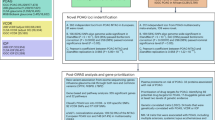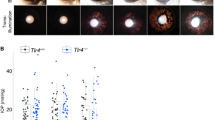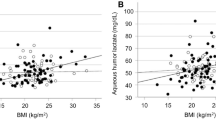Abstract
Background
Leukocyte telomere length (LTL) has been associated with various diseases, including age-related eye diseases such as cataract and age-related macular degeneration. However, the role of LTL in the longitudinal development of glaucoma is still unknown. Here we prospectively evaluate the association of LTL with glaucoma incidence and related traits, in the UK Biobank cohort.
Methods
The study cohort included 419,603 participants with complete baseline data for glaucoma analyses. Multivariable Cox proportional hazards models were used to evaluate the association between LTL and the risk of glaucoma incidence, and multivariable linear regression was employed to test the association between LTL and glaucoma-related traits.
Results
During a 13.58-year follow-up period, 7385 (1.76%) participants developed glaucoma. No association between LTL and incident glaucoma was found in either Model 1 (adjusted for age, sex, ethnicity and the ancestry components; HR = 1.011, 95% CI: 0.990–1.033; P = 0.311), or Model 2 (additionally adjusted for smoking status, alcohol consumption, body mass index, systolic blood pressure, education level, Townsend Deprivation Index, polygenic risk score for glaucoma, and history of diabetes and cardiovascular diseases; HR = 1.010, 95% CI: 0.988–1.032; P = 0.367). Non-significant associations were also observed for glaucoma-related traits, including the retinal nerve fibre layer, ganglion cell–inner plexiform layer, and intraocular pressure with LTL (all P-values > 0.05), but LTL was associated with a slightly increased vertical cup-to-disc ratio (P = 0.009).
Conclusions
This study suggested that LTL is not a major biomarker for incident glaucoma in the UK Biobank population. Further studies in different populations are warranted.
This is a preview of subscription content, access via your institution
Access options
Subscribe to this journal
Receive 18 print issues and online access
$259.00 per year
only $14.39 per issue
Buy this article
- Purchase on SpringerLink
- Instant access to full article PDF
Prices may be subject to local taxes which are calculated during checkout

Similar content being viewed by others
Data availability
The data analysed in this study are available at the https://www.ukbiobank.ac.uk/register-apply/.
References
Tham YC, Li X, Wong TY, Quigley HA, Aung T, Cheng CY. Global prevalence of glaucoma and projections of glaucoma burden through 2040: a systematic review and meta-analysis. Ophthalmology. 2014;121:2081–90.
Flammer J, Orgül S, Costa VP, Orzalesi N, Krieglstein GK, Serra LM, et al. The impact of ocular blood flow in glaucoma. Prog Retin Eye Res. 2002;21:359–93.
Tezel G. Oxidative stress in glaucomatous neurodegeneration: mechanisms and consequences. Prog Retin Eye Res. 2006;25:490–513.
Chen CL, Bojikian KD, Wen JC, Zhang Q, Xin C, Mudumbai RC, et al. Peripapillary retinal nerve fiber layer vascular microcirculation in eyes with glaucoma and single-hemifield visual field loss. JAMA Ophthalmol. 2017;135:461–8.
Weinreb RN, Aung T, Medeiros FA. The pathophysiology and treatment of glaucoma: a review. JAMA. 2014;311:1901–11.
Jha P, Banda H, Tytarenko R, Bora PS, Bora NS. Complement mediated apoptosis leads to the loss of retinal ganglion cells in animal model of glaucoma. Mol Immunol. 2011;48:2151–8.
Asefa NG, Neustaeter A, Jansonius NM, Snieder H. Heritability of glaucoma and glaucoma-related endophenotypes: Systematic review and meta-analysis. Surv Ophthalmol. 2019;64:835–51.
Codd V, Denniff M, Swinfield C, Warner SC, Papakonstantinou M, Sheth S, et al. Measurement and initial characterization of leukocyte telomere length in 474,074 participants in UK Biobank. Nat Aging. 2022;2:170–9.
Demanelis K, Jasmine F, Chen LS, Chernoff M, Tong L, Delgado D, et al. Determinants of telomere length across human tissues. Science. 2020;369:eaaz6876.
Benetos A, Kark JD, Susser E, Kimura M, Sinnreich R, Chen W, et al. Tracking and fixed ranking of leukocyte telomere length across the adult life course. Aging Cell. 2013;12:615–21.
Artero-Castro A, Rodriguez-Jimenez FJ, Jendelova P, VanderWall KB, Meyer JS, Erceg S. Glaucoma as a Neurodegenerative Disease Caused by Intrinsic Vulnerability Factors. Prog Neurobiol. 2020;193:101817.
Zheng Y, Zhang N, Wang Y, Wang F, Li G, Tse G, et al. Association between leucocyte telomere length and the risk of atrial fibrillation: An updated systematic review and meta-analysis. Ageing Res Rev. 2022;81:101707.
Révész D, Milaneschi Y, Verhoeven JE, Lin J, Penninx BW. Longitudinal Associations Between Metabolic Syndrome Components and Telomere Shortening. J Clin Endocrinol Metab. 2015;100:3050–9.
Yeap BB, Hui J, Knuiman MW, Flicker L, Divitini ML, Arscott GM, et al. U-Shaped Relationship of Leukocyte Telomere Length With All-Cause and Cancer-Related Mortality in Older Men. J Gerontol A Biol Sci Med Sci. 2021;76:164–71.
Arbeev KG, Verhulst S, Steenstrup T, Kark JD, Bagley O, Kooperberg C, et al. Association of Leukocyte Telomere Length With Mortality Among Adult Participants in 3 Longitudinal Studies. JAMA Netw Open. 2020;3:e200023.
Koller A, Brandl C, Lamina C, Zimmermann ME, Summerer M, Stark KJ, et al. Relative Telomere Length Is Associated With Age-Related Macular Degeneration in Women. Invest Ophthalmol Vis Sci. 2022;63:30.
Sanders JL, Iannaccone A, Boudreau RM, Conley YP, Opresko PL, Hsueh WC, et al. The association of cataract with leukocyte telomere length in older adults: defining a new marker of aging. J Gerontol A Biol Sci Med Sci. 2011;66:639–45.
Bycroft C, Freeman C, Petkova D, Band G, Elliott LT, Sharp K, et al. The UK Biobank resource with deep phenotyping and genomic data. Nature. 2018;562:203–9.
Sudlow C, Gallacher J, Allen N, Beral V, Burton P, Danesh J, et al. UK biobank: an open access resource for identifying the causes of a wide range of complex diseases of middle and old age. PLoS Med. 2015;12:e1001779.
Welsh S, Peakman T, Sheard S, Almond R. Comparison of DNA quantification methodology used in the DNA extraction protocol for the UK Biobank cohort. BMC Genom. 2017;18:26.
Cawthon RM. Telomere length measurement by a novel monochrome multiplex quantitative PCR method. Nucleic Acids Res. 2009;37:e21.
Craig JE, Han X, Qassim A, Hassall M, Cooke Bailey JN, Kinzy TG, et al. Multitrait analysis of glaucoma identifies new risk loci and enables polygenic prediction of disease susceptibility and progression. Nat Genet. 2020;52:160–6.
Madjedi KM, Stuart KV, Chua SYL, Ramulu PY, Warwick A, Luben RN, et al. The Association of Physical Activity with Glaucoma and Related Traits in the UK Biobank. Ophthalmology. 2023;130:1024–36.
Chan MP, Grossi CM, Khawaja AP, Yip JL, Khaw KT, Patel PJ, et al. Associations with Intraocular Pressure in a Large Cohort: Results from the UK Biobank. Ophthalmology. 2016;123:771–82.
Stuart KV, Biradar MI, Luben RN, Dhaun N, Wagner SK, Warwick AN, et al. The Association of Urinary Sodium Excretion with Glaucoma and Related Traits in a Large United Kingdom Population. Ophthalmol Glaucoma. 2024;7:499–511.
Mutz J, Roscoe CJ, Lewis CM. Exploring health in the UK Biobank: associations with sociodemographic characteristics, psychosocial factors, lifestyle and environmental exposures. BMC Med. 2021;19:240.
Patel PJ, Foster PJ, Grossi CM, Keane PA, Ko F, Lotery A, et al. Spectral-Domain Optical Coherence Tomography Imaging in 67,321 Adults: Associations with Macular Thickness in the UK Biobank Study. Ophthalmology. 2016;123:829–40.
Chua SYL, Thomas D, Allen N, Lotery A, Desai P, Patel P, et al. Cohort profile: design and methods in the eye and vision consortium of UK Biobank. BMJ Open. 2019;9:e025077.
Khawaja AP, Cooke Bailey JN, Wareham NJ, Scott RA, Simcoe M, Igo RP Jr., et al. Genome-wide analyses identify 68 new loci associated with intraocular pressure and improve risk prediction for primary open-angle glaucoma. Nat Genet. 2018;50:778–82.
Liu T, Kang JH, Stuart KV, Luben R, Foster PJ, Khaw PT, et al. The relation between leukocyte telomere length and glaucoma traits in the UK Biobank. Investig Ophthalmol Vis Sci. 2024;65:4063.
Zhou J, Chen F, Yan A, Xia X. Explore the molecular mechanism of angle-closure glaucoma in elderly patients induced telomere shortening of retinal ganglion cells through oxidative stress. Nucleosides Nucleotides Nucleic Acids. 2022;41:1024–35.
Han X, Steven K, Qassim A, Marshall HN, Bean C, Tremeer M, et al. Automated AI labeling of optic nerve head enables insights into cross-ancestry glaucoma risk and genetic discovery in >280,000 images from UKB and CLSA. Am J Hum Genet. 2021;108:1204–16.
Honig LS, Kang MS, Schupf N, Lee JH, Mayeux R. Association of shorter leukocyte telomere repeat length with dementia and mortality. Arch Neurol. 2012;69:1332–9.
Zekry D, Herrmann FR, Irminger-Finger I, Ortolan L, Genet C, Vitale AM, et al. Telomere length is not predictive of dementia or MCI conversion in the oldest old. Neurobiol Aging. 2010;31:719–20.
Wu Y, Pei Y, Yang Z, Li K, Lou X, Cui W. Accelerated telomere shortening independent of LRRK2 variants in Chinese patients with Parkinson’s disease. Aging. 2020;12:20483–92.
Eitan E, Hutchison ER, Mattson MP. Telomere shortening in neurological disorders: an abundance of unanswered questions. Trends Neurosci. 2014;37:256–63.
Armstrong E, Boonekamp J. Does oxidative stress shorten telomeres in vivo? A meta-analysis. Ageing Res Rev. 2023;85:101854.
Codd V, Nelson CP, Albrecht E, Mangino M, Deelen J, Buxton JL, et al. Identification of seven loci affecting mean telomere length and their association with disease. Nat Genet. 2013;45:422–7.e1-2.
Han X, Gharahkhani P, Hamel AR, Ong JS, Rentería ME, Mehta P, et al. Large-scale multitrait genome-wide association analyses identify hundreds of glaucoma risk loci. Nat Genet. 2023;55:1116–25.
Taub MA, Conomos MP, Keener R, Iyer KR, Weinstock JS, Yanek LR, et al. Genetic determinants of telomere length from 109,122 ancestrally diverse whole-genome sequences in TOPMed. Cell Genom. 2022;2.
Fry A, Littlejohns TJ, Sudlow C, Doherty N, Adamska L, Sprosen T, et al. Comparison of Sociodemographic and Health-Related Characteristics of UK Biobank Participants With Those of the General Population. Am J Epidemiol. 2017;186:1026–34.
Batty GD, Gale CR, Kivimäki M, Deary IJ, Bell S. Comparison of risk factor associations in UK Biobank against representative, general population based studies with conventional response rates: prospective cohort study and individual participant meta-analysis. BMJ. 2020;368:m131.
Acknowledgements
The authors thank all the participants in this study and all the research grants that supported this work.
Funding
The work in this paper was supported by the research grants from the Health and Medical Research Fund Hong Kong (07180256 [L.J.C.]); the General Research Fund, Hong Kong (14102122 & 14105320 [C.C.T.]); a Research Matching Grant (RMG) by the Hong Kong Government (8601668 [L.J.C.]); the Endowment Funds for Lam Kin Chung. Jet King-Shing Ho Glaucoma Treatment and Research Centre and Lim Por-Yen Eye Genetics Research Centre, Hong Kong SAR, China; the Chinese University of Hong Kong (CUHK) Jockey Club Myopia Prevention Programme (No grant no., [J.C.Y]); and the Chinese University of Hong Kong (CUHK) Jockey Club Children Eye Care Programme (No grant no. [J.C.Y]).
Author information
Authors and Affiliations
Contributions
JY, YZ, JCY, and LJC conceived the idea and designed the study; JY and YZ contributed to data acquisition of the study and performed data analyses; JY drafted the manuscript; CPP, CCT, JCY, and LJC provided critical review on the manuscript. All authors approved the submitted version.
Corresponding authors
Ethics declarations
Competing interests
The authors declare no conflict of interest including any financial, personal, or other relationships with other people or organizations that might influence or be perceived to influence their work.
Additional information
Publisher’s note Springer Nature remains neutral with regard to jurisdictional claims in published maps and institutional affiliations.
Supplementary information
Rights and permissions
Springer Nature or its licensor (e.g. a society or other partner) holds exclusive rights to this article under a publishing agreement with the author(s) or other rightsholder(s); author self-archiving of the accepted manuscript version of this article is solely governed by the terms of such publishing agreement and applicable law.
About this article
Cite this article
Yu, J., Zhang, Y., Pang, C.P. et al. Association between leukocyte telomere length and incident glaucoma: A prospective UK biobank study. Eye 39, 2176–2182 (2025). https://doi.org/10.1038/s41433-025-03838-7
Received:
Revised:
Accepted:
Published:
Issue date:
DOI: https://doi.org/10.1038/s41433-025-03838-7



